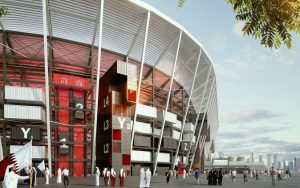FIFA 2022: World’s First Mobile Stadium Takes Shape in Qatar
Made primarily from shipping containers, Ras Abu Aboud Stadium will be completely disassembled after the tournament, with its parts repurposed to provide sporting facilities after 2022.
The 2022 World Cup will add a new chapter in FIFA history. One of the stadiums for the Cup in Qatar will host the tournament in the first movable stadium at Doha’s 40,000-seat  Ras Abu Aboud Stadium constructed partially of shipping containers.According to FIFA, the stadium will be dismantled and repurposed after Qatar 2022.The stadium, billed as the world’s first ‘demountable’ stadium, is under construction in full swing in Doha.
Ras Abu Aboud Stadium constructed partially of shipping containers.According to FIFA, the stadium will be dismantled and repurposed after Qatar 2022.The stadium, billed as the world’s first ‘demountable’ stadium, is under construction in full swing in Doha.
The Ras Abu Aboud Stadium is being built to a modular design, partly out of old shipping containers from Doha Port. Itis one of the eight new venues under construction ahead of the FIFA World Cup football competition in 2022.
The Stadium “will be entirely dismantled and repurposed post-2022, setting a new standard in tournament sustainability and legacy,” according to Supreme Committee for Delivery and Legacy (SC), which is overseeing the Qatar 2022 World Cup. Constructed using shipping containers and other modular building blocks, this innovative 40,000-seat venue will be entirely dismantled and repurposed setting a new standard in sustainability, SC said in a note release last day. After the tournament, says the SC, the “modular seats and even the roof will be disassembled and reused”.
Although it is unclear for what purpose the stadium structure will be put to use post its dismantling, the Qatari authorities note its modular design “could provide the building blocks for another 40,000-seat stadium in a different location, or for several different types of sporting or non-sporting venues”.
Also Read : Canakkale 1915: Steel Engineering Marvel to Connect Europe and Asia
The Qatar 2022 FIFA World Cup takes place from 21 November to 18 December, with 32 national teams taking part.Eight stadiums will host matches during the FIFA World Cup Qatar 2022™. Khalifa International, Al Janoub and Education City are the three venues for the World Cup. These have already been unveiled, with the  remaining five set to be completed long before the tournament kicks off on 21 November 2022.
remaining five set to be completed long before the tournament kicks off on 21 November 2022.
The FIFA World Cup Qatar 2022™ Sustainable Stadiums report – compiled by the Supreme Committee for Delivery & Legacy (SC) – outlines the sustainability features of each of the tournament venues in relation to design, construction and legacy. Bodour Al Meer, Sustainability & Environment Senior Manager at the SC said: “Sustainability has been at the heart of all our tournament preparedness efforts from the day we were awarded the rights to host the world’s largest football tournament, back in 2010.”
“In particular, we have always aimed to ensure that the construction and development of our tournament infrastructure leaves a positive legacy for our planet and sets new standards for delivering sustainable, carbon neutral, mega-sporting events in the future” said Bodour Al Meer.
“Stadiums are key in FIFA’s efforts to stage successful and more sustainable FIFA World Cups,” said Federico Addiechi, Head of Sustainability and Environment at FIFA. “With the publication of this report, we can clearly see the ways in which the FIFA World Cup 2022 preparations have delivered as per the bidding guidelines – and are continuing to deliver – on that goal. The innovative approach adopted by the SC to develop and use new environmental technologies will guarantee a significant legacy for the region and beyond.”
Since modular designsare used more than 170,000 can be removed from several venues after the tournament, with the SC planning to donate them to countries which lack sporting infrastructure. Modular design will be easy to disassemble facilities, transport them to a new location and reuse them. Made primarily from shipping containers, Ras Abu Aboud Stadium will be completely disassembled after the tournament, with its parts being repurposed to provide sporting facilities after 2022. In addition, the land occupied by the stadium will be transformed into a waterfront development which overlooks the iconic West Bay district of Doha.
Also Read : Housing and Smart Cities: Why a ‘Steel Transition’ is Required?
Fifteen per cent of building supplies for the stadiums were sourced from recycled materials. In addition, the project has prioritised using local resources wherever possible to support Qatar’s economy.  Indoor spaces are finished with non-toxic paint, while light-coloured exteriors increase reflectiveness, minimising heat retention and reducing the heating of the urban environment.
Indoor spaces are finished with non-toxic paint, while light-coloured exteriors increase reflectiveness, minimising heat retention and reducing the heating of the urban environment.
There are also plans to reuse 90 per cent of waste generated at Al Janoub and Al Rayyan Stadiums. All the stadiums are designed for effective waste management during operation. Waste segregation and recycling takes place on-site, while wastewater is recycled from on-site workers’ accommodation for dust control and toilet flushing.
As per the mandatory requirement of FIFA, each Qatar 2022 stadium must achieve a four-star rating under the Global Sustainability Assessment System (GSAS), which is managed by the Gulf Organisation for Research and Development. The sustainability certification system facilitated by GSAS measures a stadium’s design, construction and operation stages.
